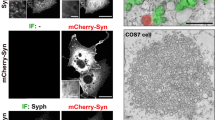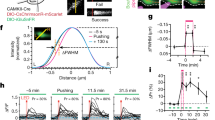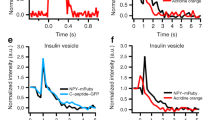Abstract
EARLY electron microscopic studies of the posterior pituitary glands of rats and toads1,2 revealed that the neurosecretory terminals contained, in addition to the electron-dense neurosecretory granules (correctly assumed to contain posterior pituitary hormones), certain structures of the same size, but electron-lucent, which were interpreted as being empty neurosecretory granules. It was concluded that on stimulation, granules release their contents in the form of a molecular dispersion which allows the hormones to traverse cytoplasm and the nerve membrane to reach the extracellular environment and, ultimately, the capillary lumen. Although various other schemes have since been proposed, they all share this concept of an essentially “intracellular” event initiating hormone release by dissociating it from sites of storage or binding (see, for example, refs. 3 and 4). And it has been emphasized repeatedly that discharge of whole granules has never been observed in electron micrographs. Nevertheless several facts are difficult to reconcile with an “intracellular” hypothesis but would favour a granule extrusion mechanism5–7. No wholly satisfactory explanation has been offered for the presence, in the neurosecretory terminals, of a great number of synaptic vesicles—the electron-lucent structures roughly one-quarter the size of the neurosecretory granules. Because these increase in number after stimulation, and for other reasons, it has been suspected that they may serve some function in mediating release of the hormones, perhaps by releasing a substance such as acetylcholine2,8. There is, however, very little experimental evidence for this.
This is a preview of subscription content, access via your institution
Access options
Subscribe to this journal
Receive 51 print issues and online access
$199.00 per year
only $3.90 per issue
Buy this article
- Purchase on Springer Link
- Instant access to full article PDF
Prices may be subject to local taxes which are calculated during checkout
Similar content being viewed by others
References
Palay, S. L., in Ultrastructure and Cellular Chemistry of Neural Tissue (edit. by Waelsch, H.), 31 (Hoeber, New York, 1957).
Gerschenfeld, H. M., Tramezzani, J. H., and De Robertis, E., Endocrinology, 66, 741 (1960).
Ginsburg, M., and Ireland, M., J. Endocrinol., 35, 289 (1966).
Thorn, N. A., Acta. Endocrinol., 53, 644 (1966).
Douglas, W. W., in Proc. Fourth Intern. Symp. on Neurosecretion (edit. by Stutinsky, F.), 178 (Springer-Verlag, Berlin, 1967).
Douglas, W. W., Brit. J. Pharmacol., 34, 451 (1968).
Fawcett, C. P., Powell, A. E., and Sachs, H., Endocrinology, 83, 1299 (1968).
Koelle, G. B., Nature, 190, 208 (1961).
Holmes, R. L., and Knowles, F. G. W., Nature, 185, 710 (1960).
Normann, T. C., Z. Zellforsch., 67, 461 (1965).
Smith, U., and Smith, D. S., J. Cell Sci., 1, 59 (1966).
Weitzman, M., Z. Zellforsch., 94, 147 (1969).
Bunt, A. H., J. Ultrastruct. Res., 28, 411 (1969).
Douglas, W. W., Nagasawa, J., and Schulz, R. A., Mem. Soc. Endocrinol. (in the press).
Author information
Authors and Affiliations
Rights and permissions
About this article
Cite this article
NAGASAWA, J., DOUGLAS, W. & SCHULZ, R. Ultrastructural Evidence of Secretion by Exocytosis and of “Synaptic Vesicle” Formation in Posterior Pituitary Glands. Nature 227, 407–409 (1970). https://doi.org/10.1038/227407a0
Received:
Issue Date:
DOI: https://doi.org/10.1038/227407a0
This article is cited by
-
Discovery of the migrasome, an organelle mediating release of cytoplasmic contents during cell migration
Cell Research (2015)
-
Stimulation-dependent uptake of an extracellular marker to subcellular fractions of isolated neurohypophysial tissue
Experientia (1983)
-
Synaptic vesicle recycling in synaptosomes in vitro
Nature (1976)
Comments
By submitting a comment you agree to abide by our Terms and Community Guidelines. If you find something abusive or that does not comply with our terms or guidelines please flag it as inappropriate.



